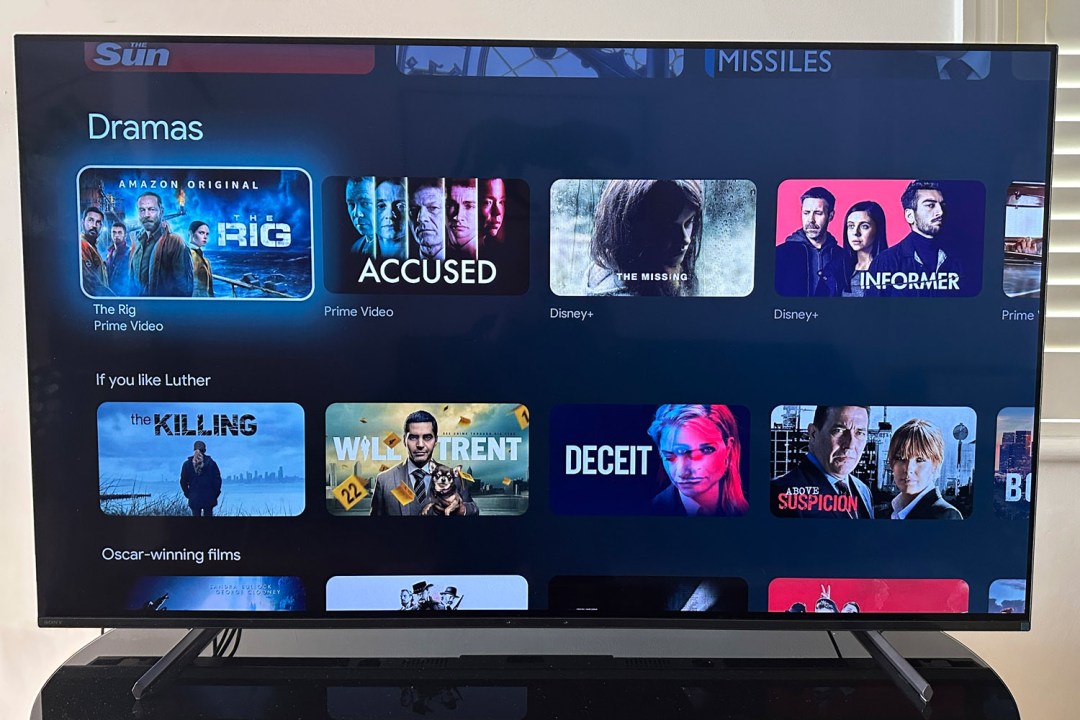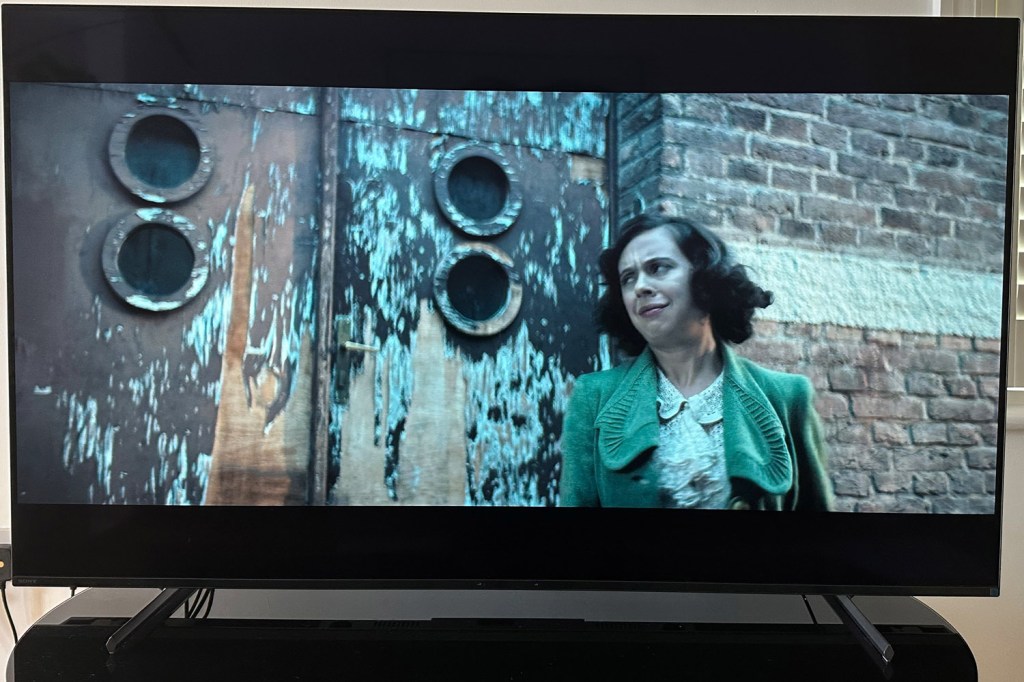Sony XR-55A80L review: impresses where it matters
It might be Sony's mainstream offering, but it delivers on image quality

We thought that when newer, more effective technologies emerged, they were supposed to make the current technology more affordable. No one seems to have told Sony, though. Despite the fact that many of the cutting-edge models in our best 4K TV list are now all about fancy-pants micro-lens array and quantum-dot OLED, the entry-level, plain-vanilla Sony XR-55A80L OLED has been priced very, um, confidently indeed.
So the questions are: is it worth it? Can ‘regular’ OLED still hold its own?
Design and build: deeper than is ideal


When we get to the features section further down the page we’ll be able to make excuses on behalf of Sony as to why the A80L is – relatively speaking – a bit of a bloater. 53mm doesn’t sound all that deep for a TV to be when it’s written down, but when you see the Sony in profile and compare it to the equivalent screens from LG or Samsung, you’ll know it’s not going to look the part if you hang it on the wall.
No, better to stand the A80L on its two slender feet. They click into place and can occupy three positions: splayed outwards towards the edges of the screen to give a clean look and a low profile; pointing inwards to make positioning on a smaller surface easier; fitted with the provided adapters to raise the bottom of the screen to the point a soundbar will fit nicely underneath.
No matter where and how it’s positioned, though, the XR-55A80L looks good from the front. Its bezels are minimal, it has no visible audio system and, though the plastics used in its construction aren’t anything special, it’s built and finished to typically high Sony standards.
Features: excite my television



While the XR-55A80L has a very useful and quite impressive set of features, its specification does have a gap or two. And more importantly, it’s specified almost identically to last year’s A80K OLED range. There hasn’t been an awful lot of progress where features are concerned.
The good stuff includes the ongoing use of the proven and impressive Cognitive Processor XR. For 2023 it has new XR Clear Image processing that’s designed to improve upscaling of sub-4K content, but in every other respect it’s the same engine we admired last year. It’s in charge of a 4K OLED panel that’s compatible with HLG, HDR10 and Dolby Vision HDR standards, and an audio system that can make sense of Dolby Atmos audio information.
Sony has been using actuators as part of its OLED TVs’ audio set-up for a good while now, and that continues here. The 55in A80L is fitted with three, and they excite the screen until it effectively becomes a speaker. The advantages are obvious: no visible audio system, and sound that comes from exactly where the pictures are. The major disadvantage – a lack of low-frequency extension – is mitigated by two down-firing bass drivers fitted to the bottom of the chassis. The other disadvantage – the relative depth of the TV’s frame – is obvious just from looking at it. Of course, this system doesn’t attempt to create the impression of spatial audio, but it’s a neat and nicely integrated way of making use of those Dolby Atmos soundtracks nevertheless.
There are more than enough wired and wireless connectivity options here, but not all of the four HDMI sockets are as well-specified as they might be. Two are at HDM 2.1 standard, which means compatibility with 4K @ 120 Hz, VRR, ALLM and all the other stuff that makes a console gamer’s experience so satisfying. One of those sockets is also eARC-enabled, but the other two are bog-standard HDMI 2.0 – so you’ll run out of top-of-the-range HDMI 2.1 inputs much more quickly than if you buy an LG screen, say, or a Samsung. Both of those brands give you four HDMI 2.1 inputs, which seems much more sensible.
Gamers will also enjoy the appearance of the new Game Menu. Sony has followed the lead of quite a few rival brands by offering quick access to the A80L’s gaming-centric settings, so you can fiddle with black levels, motion control and so on quickly and easily, without interrupting your game. And because this is a Sony, it wears a ‘Perfect for Playstation’ badge, which basically means the A80L can automatically adjust HDR tone-mapping when a PS5 is connected.
Interface: Google it


Using Google TV as a smart TV platform is never a bad idea, and it’s very well implemented on the A80L. The home screen is clean and fairly logical, it doesn’t take long to learn your viewing habits in order to make recommendations, and it doesn’t try too hard to sell you stuff. Every catch-up and streaming service worth having is here, all in their most advanced form, and there’s also Sony’s great-looking and endlessly worthwhile Bravia Core streaming service included to sweeten the deal yet further.
Navigating Google TV (as well as the brief, logical and effective set-up menus) can be done using either Google Assistant or one of the two supplied remote control handsets. There’s the usual, rather inexpensive and overburdened full-function remote, and a more slender, slightly more upmarket alternative with far fewer buttons – and the posher remote has a ‘mic’ button with which you can issue spoken instructions to the screen. Both are battery-powered, which is a pity when you consider there are solar-powered and/or USB-charging remotes available with any number of rivals.
Sony XR-55A80L performance



A Small Light on Disney+ may be grim and uncomfortable viewing, but the combination of Dolby Vision HDR and Dolby Atmos audio means it’s just as worthwhile a test of the XR-55A80L as it is compelling to watch. And there’s no two ways about it, when it comes to picture performance this Sony has nothing to apologise for.
Its unassisted OLED panel may not be the brightest around, but the white tones it creates are clean, varied and loaded with detail both broad and fine. Seen alongside the predictably deep and lustrous black tones (which are equally varied and distinct), on-screen contrasts are wide and convincing. The A80L may not be the last word in black-tone detail – it gives away the most minor and/or most transient shadow detail when compared to the best of its rivals – but its monochrome performance is enjoyable and watchable nevertheless.
It’s a similar story when it comes to all the colours in between. The Sony seems capable of creating and describing extremely subtle, nuanced variations in shade and tone, and the result is a colour palette that’s wide-ranging and vibrant, but never over-processed or too vivid. Skin tones, in particular, are varied and natural, while skin textures are characterful and convincing. The A80L can balance an image that contains deep black areas, bright white highlights and an absolute stack of colours in between with complete confidence and a total lack of stress. In the best circumstances it’s not so much like watching a TV as it is looking out of a window.
And in every other meaningful respect, the Sony is always accomplished and watchable. Motion-control is absolute, so even when the on-screen stuff combines slow camera pans with rapid action, everything is gripped with assurance. Depth of field, when the content demands it, is very good. Edge-definition is smooth, and the A80L can control tight and/or complex patterns without getting flustered. Picture noise is conspicuous only by its absence.
Switch to some content via a Playstation 5 and the results are much the same. The A80L’s facility with lighting, in particular, means contrasts and bright tones look great – even though the peak brightness here is nothing special. Colours pop when they have to, are subtle when they need to be, and have a huge amount of detail and variation within them. Motion is controlled confidently, and when in Game mode the Sony is plenty responsive enough, even if it’s not the out-and-out fastest around.
When asked to upscale sub-4K stuff, the A80L remains composed and effective. Detail levels in a Full HD off-air broadcast are still pretty high, picture noise is low, on-screen movement is handled well and edge definition holds up too. Step down in resolution further and things get a bit marginal – but on the whole the Sony is never less than watchable.
‘Watchable’ is one thing, ‘listenable’ is quite another – and despite its complex audio arrangement, the A80L doesn’t really sound all that. The fact that a lot of the sound it produces comes from the same places as it images helps with the positivity of its sonic delivery, but it’s not especially large or expansive – and tonally it’s not especially pleasant. It’s never less than a little bit thin and abrasive, and the louder you listen the harder and edgier it becomes. Despite the presence of two bass drivers, the low end is insubstantial and lightweight. And consequently the way the Sony XR-55A80L sounds is quite strongly at odds with the way it looks.
Sony XR-55A80L verdict

The Sony XR-55A80L is a straightforwardly great TV – it can do subtle, it can do vibrant, and it can make the very best of any content you feed into it. Or, at least, it can where pictures are concerned…
Stuff Says…
Sometimes ‘the current thing done really well’ is just as good as ‘the brand-new thing’. This is one of those times
Good Stuff
Excellent across-the-board picture quality
Good gaming support
Fine ergonomics and smart interface
Bad Stuff
Just two HDMI 2.1 sockets
Not the most wall-hangable design
Thin and pointy sound
Sony XR-55A80L technical specifications
| Screen size | 55 (version tested), 65, 77, 83in |
| Resolution | 3840×2160 |
| HDR | HDR10, HLG, Dolby Vision |
| Inputs | 2x HDMI 2.1, 2x HDMI 2.0, digital audio out, 2x USB, Ethernet, Wi-Fi, Bluetooth |
| Smart TV OS | Google TV |
| Dimensions | 1227x712x53mm (without stand) 1227x738x327mm (with stand) |
| Weight | 17.9kg (without stand) 18.8kg (with stand) |



